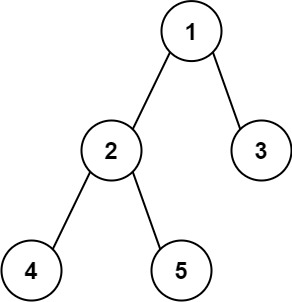Description
Given the root of a binary tree, return the length of the diameter of the tree.
The diameter of a binary tree is the length of the longest path between any two nodes in a tree. This path may or may not pass through the root.
The length of a path between two nodes is represented by the number of edges between them.
Example 1:

Input: root = [1,2,3,4,5] Output: 3 Explanation: 3 is the length of the path [4,2,1,3] or [5,2,1,3].
Example 2:
Input: root = [1,2] Output: 1
Constraints:
- The number of nodes in the tree is in the range
[1, 104]. -100 <= Node.val <= 100
Code
和 Binary Tree Maximum Path Sum 的 recursion 形式是一樣的。
/**
* Definition for a binary tree node.
* struct TreeNode {
* int val;
* TreeNode *left;
* TreeNode *right;
* TreeNode() : val(0), left(nullptr), right(nullptr) {}
* TreeNode(int x) : val(x), left(nullptr), right(nullptr) {}
* TreeNode(int x, TreeNode *left, TreeNode *right) : val(x), left(left), right(right) {}
* };
*/
class Solution {
int diameter = 0;
public:
int diameterOfBinaryTree(TreeNode* root) {
checkDiameter(root);
return diameter;
}
int checkDiameter(TreeNode* node) {
if(!node) return 0;
int left = checkDiameter(node->left);
int right = checkDiameter(node->right);
diameter = max(diameter, left + right);
return max(left, right) + 1;
}
};